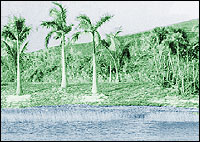|
The NW 58 St. landfill, once an EPA Superfund site, is
now the model of environmental consciousness. Not only does the
existing state-of-the-art Resource Recovery Facility process 95% of
the waste coming to the site, but a portion of the former landfill
itself is being transformed back into its original state: a native
wetland.

The new "scrubbing" towers at the Resources Recovery
Facility.
The Resource Recovery Facility contracted Montenay
Power Corp. to run its day-to-day operations.
Subsequently, Montenay Power Corp. worked in
conjunction with the Department of Solid Waste Management to complete
a recent update of the facility.

The restored wetlands at the NW 58 St. landfill site.
Metro-Dade County Department of Solid Waste Management
Environmental Compliance Chief Lee S. Casey said, "It is one of
the largest waste-to-energy facilities anywhere. Almost all of the
waste is utilized in some form or another."
First of all, metals are removed from the garbage
(household waste) as a part of the front-end separation process, and
all aluminum products and other metals accumulated are sold.
The garbage that is left is turned into refuse derived
fuel (RDF), and is used not only to power the plant, but also to
provide energy to some 40,000 additional homes.
The trash (yard waste and dumpster refuse) that is
delivered to the plant is separated as well, and any metals gleaned
from that are also sold. The trash separation process also produces
two types of soil product, one that is sold for agricultural use and
another called "unders" used at the South Dade Landfill.
The "biomass" fuel produced from the trash
is typically sold to fossil fuel plants in central Florida but it can
even be burned on-site.
"Fast doors" (which close behind each truck)
help reduce the smell of the freshly delivered waste, but it is the
new smokestacks that play perhaps the largest role in reducing the
smell.
Casey explained, "By pumping the chemical milk
lime in with the gas in the cylinders, a reaction occurs that produces
a certain type of gas."
The resulting gas, when filtered, reduces the
visibility of emissions by 90% and easily meets the new EPA and FDEP
standards.
The resulting waste, ash and non-processed products,
from these procedures is placed in a much smaller nearby landfill.
And that amount might be reduced even further should a
proposed plan to pass magnets again over the remaining ash (to remove
any metals that might have been missed) be approved.
But even though this small "ashfill" is
still in use, the landfill that towers over the site is no longer in
operation. In fact, some 35 acres worth of wetlands near that site
have been restored.
The main thrust of the rehabilitation of the wetlands
has been getting rid of non-native vegetation, especially the horrible
Malaleuca trees and Australian Pines that have come to dominate parts
of South Florida. The county's environmentalists have found that by
simply restoring the native plant life of the area, wildlife has been
attracted back.
"The Malaleuca eradication
project,"explained Casey, "was crucial to the success of the
restoration. Aerial spraying killed about 70% of the trees, and the
rest we've tried to get rid of through injection. And by letting the
trees deadfall instead of cutting them down it provides snags for
native birds to roost on."
County Environmental Compliance Specialist Megan
Clouser explained, "All the animals that have come back
congregated here naturally. We didn't bring any of them in, we just
provided a native environment for them."
And oh how they've come back!
The bird population out at the site includes a flock
of flamingos, bald eagles, wood storks, osprey, every kind of heron
you can imagine, and many others.
Not only that, but the basin that serves as the
foundation for the wetlands is home to several alligators, which
believe it or not is a positive sign.
County Manager for Environmental Affairs German
Hernandez explained, "When you see that there is a predator/prey
relationship, the area has become a viable wetlands environment."
The site is not open to the public but tours are
available. To take a tour of the restored wetlands, call the customer
service line at 305 594 1500.
|